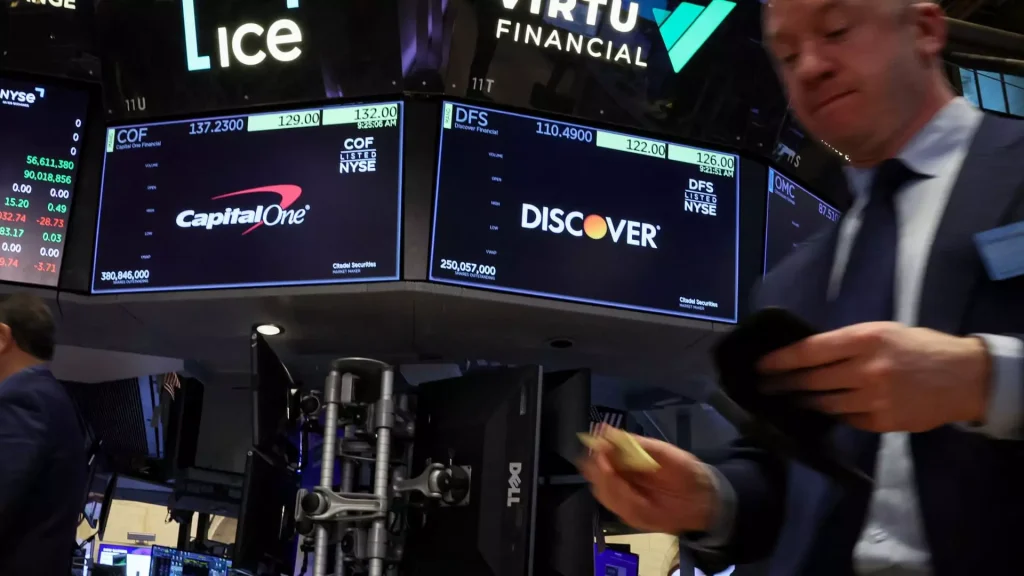The financial arena is buzzing with anticipation as analysts speculate on the monumental merger between Capital One and Discover Financial Services. BTIG recently projected that if the merger proceeds, Capital One’s stock could skyrocket to an impressive $427 per share, reflecting a staggering potential growth of over 137% from its current price. This projection is not just optimistic—it’s based on an in-depth analysis of market dynamics and Capital One’s strategic positioning within the financial services sector.

The merger, while awaiting regulatory approval, has already stirred numerous discussions concerning its implications for the financial landscape. At its core, this deal embodies the crucial importance of leveraging technological advancements to enhance competitive positioning. If Capital One can capitalize on Discover’s relatively untapped payments network, it stands poised not only to capture a larger slice of the prime credit card market but also to redefine consumer engagement through improved payment solutions.
Strategic Advantages: Tapping Into Discover’s Network
The essence of BTIG’s bullish stance lies in what they refer to as Discover’s “unpolished diamond” – its payments network, which, when combined with Capital One’s technological prowess, could yield formidable results against titans like Visa and Mastercard. Imagine a scenario where Capital One seamlessly integrates Discover’s capabilities, creating a more formidable competitor in the credit space. This synergy could foster significant innovation, ultimately translating to richer consumer experiences and increased market share.
Moreover, even in the event the merger doesn’t materialize, analysts aren’t completely bearish on Capital One’s prospects. BTIG has assigned a standalone target price of $208 per share, signaling a respectable upside from current levels. The rationale stems from the excess capital that Capital One has amassed since the merger announcement, leading to possibilities for substantial stock buybacks which can bolster earnings per share and enhance shareholder value.
Risk Factors and Regulatory Hurdles
However, the path to a successful merger is fraught with challenges. Recently, concerns raised by the U.S. Department of Justice regarding potential monopolistic tendencies in the subprime market has led to a wave of speculation that the merger may face significant scrutiny. The Justice Department’s hesitance highlights the fine line that financial institutions must navigate between growth and regulation. While Capital One maintains that the merger is constructed to meet all legal standards, it would be naive to ignore the realities of regulatory pushback in a climate heavily focused on consumer protection.
The conversations surrounding antitrust implications could complicate the merger narrative; yet, Capital One’s strategic leadership, under CEO Richard Fairbank, appears resolute. Should regulators voice concerns, Fairbank’s willingness to negotiate—potentially jettisoning portions of Discover’s subprime offerings—could serve as a pragmatic route to obtaining approval and placating governmental apprehensions.
Investor Sentiment and Market Movements
Investor sentiment remains cautiously optimistic. Capital One’s shares experienced resistance and rebounded from initial sell-offs tied to merger apprehensions, reflecting a sentiment that perhaps the market understands both balls-in-play: the strides they can make with the merger and their robust standalone capability. The recent uptick of nearly 6% since mid-March signifies that investors may be placing their bets on the vision of a stronger, more integrated Capital One emerging from the merger process.
In this environment, notable financial analysts, including those at Citi and Jefferies, continue to champion Capital One, indicating their belief in the eventual success of the merger. This kind of analyst endorsement provides critical support for the company amid a wave of skepticism and market volatility. Such expert endorsement begs the question: are investors seeing the bigger picture or simply riding waves of optimism?
The Bigger Picture: Capital One’s Place in the Market
With the increasing complexities of consumer financial behavior and the rapidly evolving tech landscape, Capital One stands at a pivotal juncture. The successful completion of the Discover merger could serve not only to amplify their strategic position but to fortify their brand against the backdrop of economic uncertainty.
Capital One’s initiative to tighten underwriting standards prior to this merger has already provided them with a buffer against economic fluctuations. It’s a forward-thinking decision that exemplifies their proactive nature in a dynamic market filled with potential disruptions. This adaptability underscores a significant strategic advantage that could pay dividends far beyond the immediate merger concerns.

In the end, as analysts forecast an exciting future for Capital One, the company’s leadership appears prepared to adapt, evolve, and confront the hurdles ahead. The conversations surrounding its merger with Discover Financial Services encapsulate broader themes in the financial sector—innovation, regulation, and the quest for market dominance in an increasingly competitive landscape. The real test lies in whether this anticipated synergy will yield the game-changing results so many are predicting.

